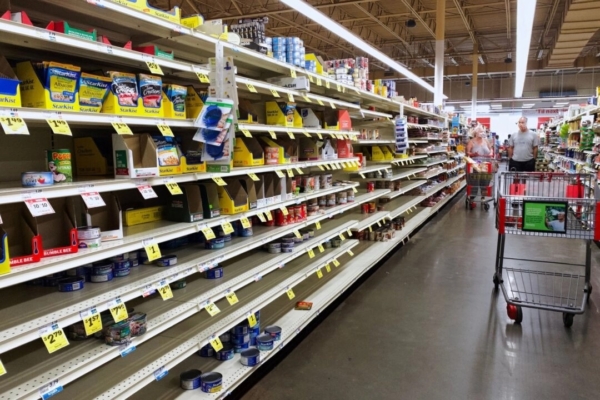Inflation rose in October, but remains relatively stable overall. The Personal Consumption Expenditures Price Index (PCEPI) is the Federal Reserve’s preferred measure of inflation. In October 2024, the year-over-year compound growth rate was 2.9%, with a 2.1% annualized growth rate over the past three months and a 2.3% growth rate over the past year.
The core PCEPI inflation rate in October 2024 was 3.3%, excluding volatile food and energy prices but including the more delayed housing services prices, with average inflation values of 2.8% over the past three months and the past year.
Why did inflation rise in October? Adverse supply conditions were at least partially to blame. Hurricane “Helene” swept through Florida, Georgia, North Carolina, and Tennessee at the end of September, causing disruptions and flooding. Dock workers went on strike in early October, halting about half of national deep-sea shipping. Subsequently, Hurricane “Milton” hit Florida, further limiting supplies and causing a temporary price surge.
Many still remember how similar supply constraints were used to explain the high inflation at the end of 2021, and early 2022 and 2023. However, unlike the current situation, inflation back then was more related to demand-side factors.
When output decreases, prices rise, but when output returns, prices should revert to their previous trends. However, with output recovering from the COVID-19 pandemic and related economic restrictions, prices have remained high for an extended period. Hence, besides supply constraints, there are other factors explaining the observed excessive inflation during this period.
Some researchers still argue that post-pandemic inflation is mainly supply-driven. In a recent article in The Washington Post, Peter Orszag summarized research results with Robin Brooks and William Murdock:
“The results show that supply chain variables directly accounted for 79% of the baseline inflation increase in 2021. These effects continued into 2022, with sustained supply issues directly accounting for 60% of that year’s inflation increase. The remainder largely results from spillovers from the supply-driven inflation in 2021. All this meant that demand-driven effects, such as COVID relief programs, had only a limited impact.”
However, let’s not jump to conclusions so quickly! As Josh Hendrickson explained, micro-level data, such as increased transport times or CEOs’ testimonies, often do not help determine whether inflation is supply or demand-driven. Instead, we must focus on macro expenditure data.
Through a simple identity, we can conduct counterfactual price level predictions to estimate the extent to which post-pandemic inflation is supply-driven.
Starting from this identity, total expenditure in an economy must equal the nominal value of all purchases. This is just two sides of the same transaction – when you spend money, you receive goods or services. If you pay more, you get change; if you pay less, the seller alarms. Therefore, the amount of expenditure equals the nominal value of goods or services sold.
Moreover, the nominal value of goods or services sold equals the price of goods or services multiplied by their actual quantity. Thus, for the macroeconomy, nominal expenditure equals the price level multiplied by actual output.
Next, consider if we only experienced supply disruptions, meaning, if nominal expenditure remained stable, how high would prices be today.
In the five years before the pandemic, the annualized growth rate of nominal expenditure was 4.1%. The actual GDP growth rate was 2.5%, with inflation measured by GDP deflator averaging 1.5%.
From the first quarter of 2020 to the third quarter of 2024, the average actual GDP growth rate was only 2.3%. If nominal expenditure continued to grow at pre-pandemic rates, the average inflation rate during this period would be 1.7%. This implies an increase of about 20 basis points per year over the past 4.75 years.
If only we were so fortunate! However, the actual inflation rate has been much higher than indicated by the counterfactual prediction. Since the first quarter of 2020, the average growth rate of the GDP deflator has been 3.9%, about 220 basis points higher than suggested by the prediction. As the prediction only considered supply-driven inflation, any additional inflation must be attributed to demand.
How much of the post-pandemic excess inflation is due to supply constraints? Looking at the predictions, it was expected to increase by 20 basis points per year, with excess inflation being about 220 + 20 = 240 basis points. Therefore, only around (20/240) one-twelfth, or 8.3% of the observed excess inflation during the post-pandemic period can be attributed to supply factors, meaning approximately 91.7% of the excess inflation during this period is demand-driven.
Is the recent inflation rise primarily driven by demand? This is indeed a possibility, but seems unlikely as monetary policy remains tight and nominal expenditure has slowed.
By obtaining the correct data, we can assess whether recent inflation is supply-driven. If adverse supply shocks pushed prices up in October, we should see a decrease in the inflation rate as supplies recover in the coming months. Time will ultimately reveal all. However, for now, the argument for supply-driven inflation seems more compelling than before.

